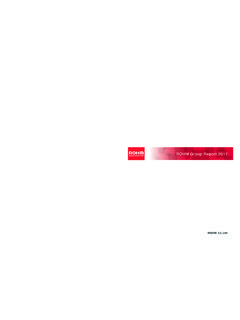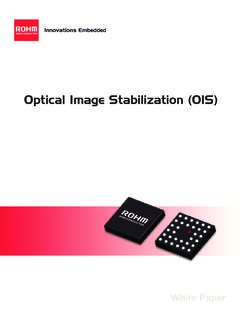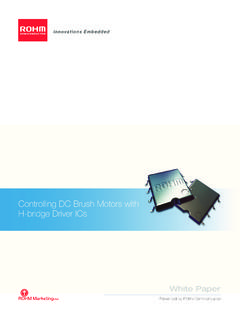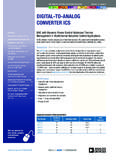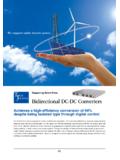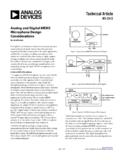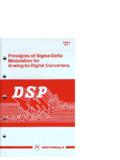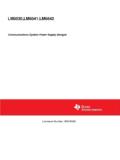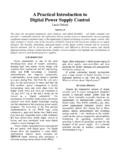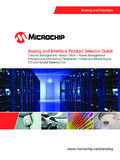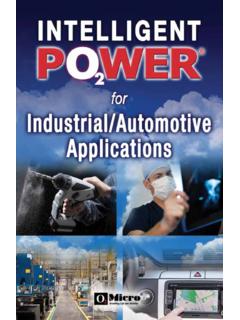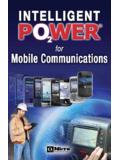Transcription of Controlling DC Brush Motors with H-bridge Driver ICs
1 Controlling DC Brush Motors with H-bridge Driver ICs ROHM MarketingUSAI n n o v a t i o n s E m b e d d e dWhite PaperPresented by ROHM SemiconductorIntroductionDC Brush Motors are increasingly required for a broad range of applications including robotics, portable electronics, sporting equipment, appliances, medical devices, automotive applications, power tools and many others. The motor itself is a preferred alternative because it is simple, reliable and low cost. Equally important, advanced, fully-integrated H-bridge Driver ICs are avail-able to control the motor s direction, speed and braking. This paper will explore the basics of H-bridge drivers and discuss the advancement of the technology from discrete solutions to highly-integrated ICs.
2 It will com-pare linear motor speed control with more advanced, higher-efficiency pulse-width modulation (PWM) techniques. The reader will be introduced to ROHM s unique product family which incorporates numerous advanced features including high-efficiency PWM outputs, integrated tim-ing and control circuitry as well as the unique capability of handling either analog or digital (PWM) speed control inputs. The paper will also describe the benefits of these advanced motor Driver ICs particularly in terms of their exceptional efficiency, integrated fault protection, small package size, symmetrical pin configurations and pin-compatibility with earlier (linear output) models.
3 Finally, a summary of the range of H-bridge ICs offered by ROHM including devices specified with 7 V, 18 V and 36 V VCC, as well single packages containing two selected (matched) drivers is BasicsThe H-bridge circuit derives its name from the full-bridge circuit shown in Figure 1. The motor forms the cross-piece in the H. Speed and direction are controlled as current flows through the motor in the direction deter-mined by the position of the switches in the bridge. In this example, with switches A and D closed, the motor will operate in a clockwise (CW) direction. With B and C closed, the motor will operate in the coun-terclockwise (CCW) direction.
4 In the linear output control implementation, the motor speed control is determined by the voltage applied across the motor. In the PWM implementation, the speed is controlled by the width of series of pulses of equal voltage. In either case, motor direction is con-trolled via separate logic DC Brush Motors with H-bridge Driver ICsAdvanced-design integrated circuits combine control and protection functions; offer upgrade path from legacy designs and selection of control strategies Figure 1. Simplified H-bridge Schematic ROHM Semiconductor H-bridge Driver ICs 1 While the concept is simple, implementation is any-thing but simple if discrete components are employed.
5 Controlling the operation of the switches and prevent-ing simultaneous closure of the CW and CCW control outputs, particularly when reversing the direction of the motor or changing speed by dynamic braking requires an H-bridge controller. The H-bridge controller is then connected to four devices forming the legs of the bridge. In a discrete solution the designer must deal with volt-age control levels, timing to prevent shoot-through and the proper selection of the semiconductor switches. The discrete solution also requires additional circuitry for functions including overvoltage, overcurrent, overtem-perature and electrostatic discharge (ESD) protection.
6 All of this translates to a fairly complex design process resulting in a higher component count, larger footprint, and less reliable design solution than a fully-integrated LSI Driver TopologyIntegrated H-bridge drivers are constructed by combin-ing a controller, output drivers and protection circuits into a single package. The first H-bridge drivers used bipolar power transistors and bipolar control circuitry. The bipolar outputs were typically operated in the linear mode to provide speed control. Simple IC processing made the circuit practical even though die sizes were large to optimize power dissipation. A limitation of the bipolar output devices was higher power dissipation, especially in the speed control mode.
7 The use of power MOSFETs for the output devices was a natural transition for H-bridge drivers. In addition to the lower losses for a given voltage rating and smaller die size, voltage-controlled MOSFETs are easier to drive than the current-driven bipolar switches, facilitating efficient PWM control. In addition to higher efficiency, PWM provides tighter motor speed control as well as faster response. BiCMOS design for the control portion takes advantages of the strengths of bipolar and CMOS design providing high drive capability and low power dis-sipation. A comparison of the power dissipation char-acteristics of linear H-bridge drivers vs. the latest PWM output drivers is shown in Figure improvements in power MOSFETs have increasingly shrunk the die size to handle a particular voltage and low on-resistance.
8 Today, control circuitry and the four output drivers are offered in surface mount packages comparable to or only slightly larger than only one of the output switches required in a discrete imple-mentation. In summary, the H-bridge motor Driver IC provides a monolithic solution to the control and output functions required to control the direction and speed of DC Brush Motors . We will now discuss the latest ROHM imple-mentation that allows designers to utilize a variety of control strategies, both analog and digital, while provid-ing the precision and efficiency of PWM 2. Comparison of linear vs. PWM implementation. In the linear implementation, at anything but full speed, the voltage drop across the control transistors results in significant power dissipation.
9 ROHM Semiconductor H-bridge Driver ICs 2 The Ideal H-bridge DriverWith BiCMOS control and power MOSFET technology, the latest generation of ROHM devices represent the ideal integrated H-bridge Driver . Figure 3 shows a block diagram of the functional elements. To handle either analog or digital inputs, the unit provides dual-mode speed control. VREF provides the analog input. The chip converts the linear input at VREF into efficient speed con-trol using its internal PWM conversion circuitry. FIN and RIN are used with a microcontroller (MCU) or other digital logic inputs to control direction and control logic takes input from the analog and digi-tal source and efficiently controls the forward / reverse directions, speed and braking of the motor by switching the appropriate integrated power MOSFETs.
10 ROHM s P-Channel / N-Channel high-power CMOS output pro-vides low on-resistance without requiring a charge pump and the associated external capacitors needed for the N-Channel MOSFETs in the high side switches common in many integrated H-bridge drivers. Rugged recovery diodes built into the struc-ture eliminate the need for additional external recovery diodes. Combined bipolar and CMOS processing in a single chip design achieves less than 1 A current in standby mode. This is an important consideration for portable, battery-powered protect the motor and the Driver , protective circuitry includes: Overvoltage protection (OVP) Undervoltage lockout (UVLO) Overcurrent protection (OCP) Thermal shutdown (TSD) Overlap (shoot-through) protection High ESD protection (4 kV) ROHM Semiconductor H-bridge Driver ICs 3 Figure 3.
